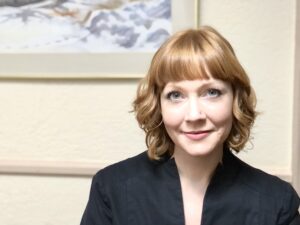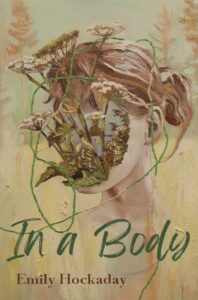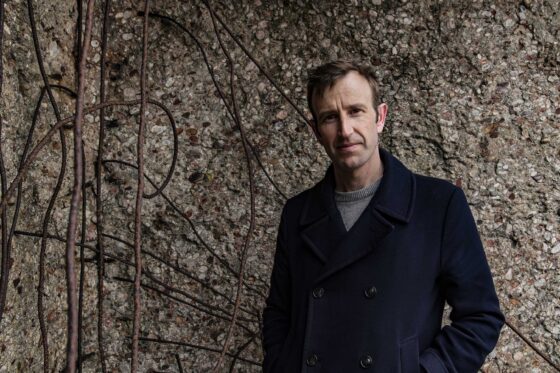
Emily Hockaday is inspired by the world around her. No, literally. She is the author of the forthcoming collection, In a Body (Harbor Editions, 2023), a refreshing and illuminating take on ecopoetry through the lens of chronic pain and illness. With six poetry chapbooks under her belt, this will be her second full-length collection after her debut, Naming the Ghost (Cornerstone Press), came out last year. As a poet, her work is often concerned with matters of ecology, parenthood, chronic illness, grief, and the urban environment. In a Body is no different in that it seeks to understand how a body—plant, human, aquatic, animal, celestial—struggling to survive and thrive fits into its larger ecosystem.
As a fellow member of the Queens Council on the Arts’ Artist Peer Circle with me, I was delighted to devote time to speak with her over email about the ways in which her fibromyalgia diagnosis inspired the collection, how rich she finds various fields of science for metaphor and art, the relationship between the urban and the natural worlds, and how collaborations with other writers helped bring these poems to life.
***
The Rumpus: Your new full-length poetry collection explores chronic pain and illness through an ecopoetry lens. Can you tell us about what inspired these poems and led you to create this book?
Emily Hockaday: In 2019, I was diagnosed with a chronic illness—fibromyalgia. This illness is mainly defined by its symptoms, which for me presented as chronic fatigue and chronic pain. After receiving the diagnosis, I felt relief but then also a sense of dread as I realized this is my life now. It was hard to accept. I was so grateful that my illness was something more benign than it could have been, but now I had to live with the fact that I might be in pain and have much less energy than I was accustomed to . . . indefinitely.

Being in constant pain, even when you know why, is very unsettling, and bowing out of social plans at the last minute due to fatigue can be really depressing and isolating. The adjustment was difficult, and because the illness is invisible, I felt like my friends and family couldn’t totally appreciate how disabling it could be. I think it was also hard for me to accept that it was disabling, and I tried to power through a lot when I probably shouldn’t have.
During this time, I started comparing my body to natural bodies in my writing. I was trying to figure out this new ecosystem of my body—adrenaline, nervous system, fatigue—and see how it looked, held up to the world. I have always been fascinated by how the pieces of an ecosystem or plant or animal bodies rely on and inform each other, and I wanted to look at that in myself and see myself as part of that. It made me feel less alone to think of myself as one speck on this Earth. A tiny piece of the universe. And by looking at myself and my body this way, I was able to move toward acceptance and start to be at peace again, even though my life looked different than it had before.
Rumpus: One of the most powerful recurring images to appear throughout the book was the body as a tree, connected to the Earth and each other via a complex and intelligent root system. Can you explain what drew you to that metaphor and how it relates to pain, chronic illness, and general physiology? You capture these so beautifully in poems such as “Body in the Spring” with lines like “Somewhere inside the beating muscle / was the sweet smell of rainy decay” and “Insects wriggle beneath the rotting bark; / mushrooms and ferns reach / from the wet meat of me”?
Hockaday: Learning about tree communication and the mycorrhizal network of fungus that acts as a sort of underground nutrient/information highway was so fascinating to me. As a kid, I was convinced that trees could speak to each other—I think I heard one story about a blight antibody forming in the center of the woods well before the disease made its way in from the edges where it was hitting, and that was it, I was totally convinced. And it is so delightful to see scientists confirming what naturalists and those who pay attention have known for a long time. I definitely would not have guessed that information was being carried through underground fungal networks, so that was just remarkable to me. And this is an area where scientists are still unsure of many of the details—are trees asking the fungal network for nutrients when they are deficient, or is the fungal network siphoning surplus to deficiencies independently, sort of tending the forest? One kind of wild thing I learned is that a fungal hyphae can puncture an insect and suck those nutrients through the network straight to a tree that might need them. I get so excited about this topic!
But, back to your question: the crux of fibromyalgia is that the nervous system is sending pain signals through the body seemingly for no reason. This can stimulate the sympathetic nervous system, which will then send adrenaline out—what fun. I wanted to look at these systems as independent but also interacting with the body and systems around them. I wanted to look at myself as a body that could sustain life even while it was falling into disrepair. I felt like that tree stump—full of potential but maybe at the end. And even though I am not literally connected to the bodies around me by an incredible “forest brain,” we are connected. I wanted to believe that when I needed something, the root system would provide it, and in the end I’d be able to dump all of my nutrients back into it to help sustain healthy growth.
Rumpus: The life cycle is a major theme in this book, which makes sense: a body is created, it lives, perhaps it spawns or multiplies, then it dies, and something new is created from it. While this is a fact of life, it does not exist in a vacuum. Anxiety and fear of death is also present in some poems, especially as it relates to personal grief, as well as the impending demise of our planet. What does renewal mean to you in the context of this collection?
Hockaday: Renewal is a big theme in this collection. This book is definitely post diagnosis, but just barely. So a lot of these poems are grappling with the fact of my life: that I will, for the foreseeable future, keep living it. Before my diagnosis, I couldn’t see the future because I was so worried that the alarming symptoms I was experiencing would end up being very serious. So some of that anxiety and existential questioning carries into these poems, but there are also poems where that is in the rearview, and renewal is here, it’s happening, but it’s not happening necessarily the way I might have thought or wanted. I’m getting to live my life, but it will be a completely new one. I’m not going to be going back to how it was before, and I’m going to have to learn to find joy anyway. I think the poems where the speaker sees herself as wild or kind of going feral epitomize trying to get that spark back while also trying to balance domestic life.
And there’s this sense of aging, too, as the speaker is a parent and is grieving her father, so the generations are moving along, or renewing, and she sees herself as the generation who is next on the chopping block. And so she turns to nature to see how the dead can nurture new life. Or, as in “Self Portrait,” how death is just another molecular change: “These molecules / cannot be stopped in their momentum / or metamorphosis. The carbon in my skin / must continue. Be comforted!”
As far as climate grief goes, this is something I am still grappling with—I don’t know if it comes through in the collection, but I do feel better knowing that the Earth will just do what it’s always done no matter what kind of damage humans do. It’ll adapt and change and continue until the planet is literally consumed by the sun. And that’s it’s own kind of renewal.
Rumpus: Sobriety and recovery is also present in this collection. It seems like a natural fit, when so many poems explore the desire for control vs. the importance of relinquishing control, a tenet of twelve-step programs. What was your creative process in determining how these poems would fit in this collection?
Hockaday: These poems entered subconsciously, and when I was ordering and assembling the collection, I noticed that they had become the ghost of a theme. At that point I had to decide whether to leave that in there or take it out. I chose for them to stay because the theme of recovery—in terms of accepting my health and regaining mental health—are so strong in this book that sobriety seemed just another extension of that. And chronologically they were where they belonged—I became sober in the wake of my fibromyalgia diagnosis as I was trying to change my routines and health hoping to find some variable that could help. At that point I wasn’t drinking very frequently, so it was easy to cut out, but once I realized I intended to stay sober, then I started to mourn the person I had been in my twenties (whether she deserved to be mourned or not).
By the time I was assembling this manuscript, I had other sobriety poems that didn’t fit the vibe of this collection, so these were definitely prototypes in a way of what I would continue working on.
Rumpus: Time and the universe are bodies in this collection, too. In “Red Shift,” you write “Time especially / is beyond escape. The rumble grows / stronger until my body is the chamber / of a cello that echoes / our expanding Universe.” In June of this year, NANOGrav published the first documented evidence of ripples in space and time, which an astrophysicist at Columbia described as gravitational waves coming from “supermassive black hole binaries, slowly and calmly orbiting each other [before collapsing into each other], . . . the tenors and bass of the cosmic opera.”
How do you feel about scientists confirming what poets have known all along? What can we as artists learn from the various fields of science, and what can scientists learn from us?
Hockaday: When I saw this news from NANOGrav in June, the first thing I thought was that I couldn’t wait to put it in a poem. I haven’t yet, though! Grabbing scientific discoveries and tidbits for my poetry brings me so much joy. Space is rife with metaphor potential! As is modern physics! It feels almost like cheating, but I can’t resist it.
I’m gleeful that you asked this because it means I can share how the LIGO sounds of gravitational waves and studies of the expanding Universe helped inspire this poem. The first sound files of gravitational waves came out in 2016, I believe, from LIGO, discovered in 2015, and they took the science world by storm. The fact that astronomers and physicists study light from parts of the Universe that exist deep in the past as well as places where the Universe is still creating itself is absolutely wild and yet we take it for granted.
So yes, I think poets have everything to learn from scientists—if we want to. That’s not everyone’s cup of tea, but I love it. As far as science learning from poets—I think through the years there has always been a tether between poetry and science. Both fields are trying to observe, to define, to name, and to understand. Scientists may find that allowing room for metaphor and looking for parallels between micro and macro and between fields may lead to discovery, and I think that’s something that poets have always known.
Rumpus: You are based in New York City, and yet so much of your work, especially in this volume, is concerned with the natural world. Jamaica Bay Wildlife Refuge, Forest Park, and Fire Island all appear as settings in this book. Can you speak about the relationship between the natural and the urban and how this influences your work?
Hockaday: I love experiencing nature in the city. I love remembering that Manhattan is surrounded by rivers and harbors that are full of oyster reefs and all kinds of algae and shipworms, crabs, and fish. I think here in the city we really cherish our moments of nature. When we go for walks, my daughter always notices when a wildflower is sprouting from a crack in the sidewalk. At night, raccoons walk along the fences that enclose our tiny backyards, like those fence lines are their evening highway system.
As you allude to in your question, the urban world and the natural world are the same world. Just as my body that might ache all night is the same body that gives me pleasure. And I feel it aching because I am alive and living in it. Likewise, along with grief, there is the experience of having loved.
I don’t like to think of the city as at odds with nature. The city is in nature. And I spend a lot of time seeking out wild spaces—Jamaica Bay, Forest Park, Alley Pond Park—that have been preserved and protected in Queens. I think I probably still need to work on not seeing my body as at odds with me, and that is something I tackled in writing these poems.
Rumpus: Were there any books, poems, films, TV shows, or other writers that had a particular impact on you while devising this collection?
Hockaday: I actually wrote the first half of this book in a back-and-forth with poet Jackie Sherbow. We sent poems responding to each others’ work for a month, and I ended up with the start of this collection. Their work is always a great influence on me, but in this case I literally wouldn’t have this book without them! There was a lot of magic in that poetic exchange.
After I wrote the collection, but before I finished editing it, I did a deep dive on ecopoetry, and those voices were very influential in how I looked at the poems I was editing. I read Camille Dungy’s Trophic Cascade, Catherine Esposito Prescott’s Accidental Garden, and Hila Ratzabi’s There Are Still Woods. Also post-writing, pre-editing, I read some body poetry collections including Ja’net Danielo’s microchap This Body I Have Tried to Write and Nicole Callihan’s This Strange Garment.
I feel like I’m always touting the New York Times’ Tuesday Science section accidentally, but the articles there are always a good place for me to seek inspiration, and I’m sure some of these poems came from reading those sections, at least passively.
Rumpus: What are you currently working on?
Hockaday: I’m working on a few things right now. I have a pile of pantoums I need to decide what to do with. I’m currently deep in the editing process with those. Some of them are staying pantoums and others are in flux. As I mentioned before, I’ve also been writing about sobriety. And I’m leaning more into climate poetry with my ecopoetry now too.
Closer to finished is a manuscript that I’m polishing and sending around that chronicles my pregnancy and my father’s diagnosis and death from ALS. There are also themes of a family member’s addiction woven into that collection. In some ways this is another body collection—this time a look at how bodies change in the face of death and birth. But it also focuses on how love persists and changes through those milestones as well.
Rumpus: What do you hope readers will take away from In a Body?
Hockaday: I hope that these poems validate the struggles of corporeal form—especially when living in an ill body and trying to reconcile that with the other identities we have—while also helping folks feel at peace with their place in connection to nature and in connection to the bodies that share our planet and our universe. I want to reach across those feelings of isolation and say: look, our DNA is 50% the same as tree DNA and 99.9% the same as all human life. We feel alone inside these vehicles, but we’re alone together and just small pieces of a whole. I hope the collection might help folks be kinder to their own bodies—and maybe the planet and the other bodies that call it home too.
***
Author photograph by Raymond Carey




